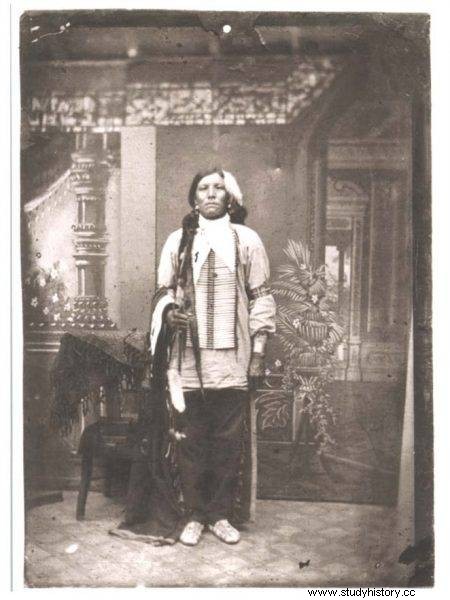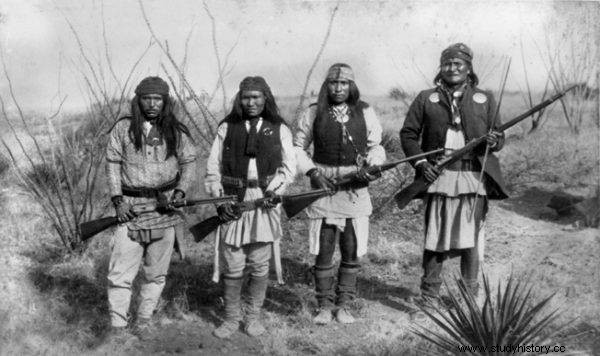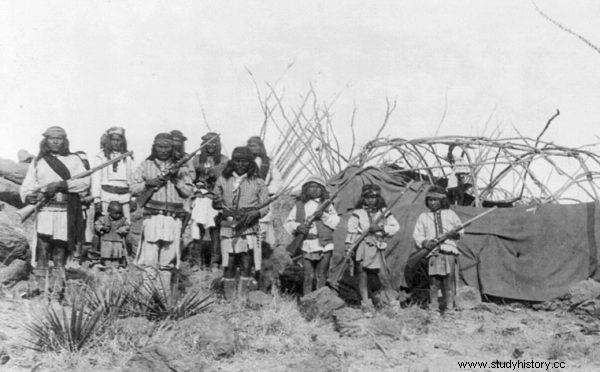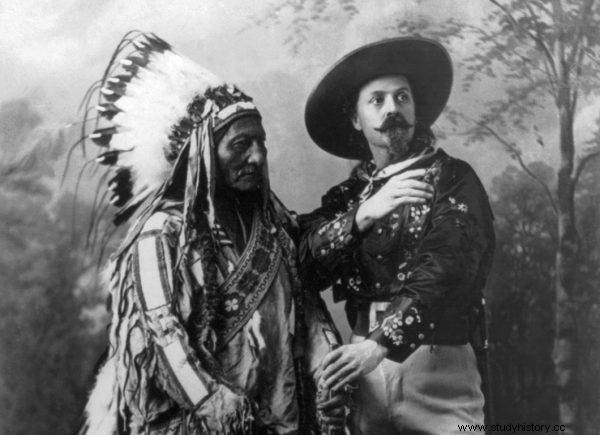The Crazy Horse, Geronimo and the Sitting Bull are legends of the Wild West. They are the inspiration for most westerns. Why did these Indians become so popular?
Crazy Horse
Crazy Horse was born around 1840. He was the Lakota war leader in the nineteenth century. Its main goal was to fight the US Federal Government. He was a staunch opponent of the expansion of white American settlers into Native American territory. He wanted to preserve the Indian identity and culture and respect native rituals, customs and laws. He took part in several famous battles of the Black Hills War in the northern Great Plains. Among other things, in the battle with Fetterman in 1866, during which he was used as bait, and in the Battle of Little Bighorn in 1876, in which he led his troop to victory. His achievements earned him respect among the Indians as well as their enemies.
Refusing to abide by the provisions of the Second Fort Laramie Treaty in 1868, the Mad Horse led his men to the still untamed territories of the country. There they continued to hunt, fished, and waged wars against hostile tribes, as well as the whites. When gold was discovered in the Black Hills of Dakota in 1874, prospectors disregarded the laws of the Sioux treaties. They started coming to the reserve there.
Wanted
General George Crook decided to force the Mad Horse to leave the winter camps by force located on the Tongue and Powder Rivers in the Montana Territory. The chief withdrew into the hills. Then he attacked Crook in the Rosebud Valley (June 17, 1876), which forced him to resign. He later moved north to reunite with the main Sioux camp.

Alleged image of the Mad Horse (the authenticity of the photo is being questioned)
He was pursued by Colonel Nelson A. Miles in connection with a military campaign to force all Native Americans to join government agencies . Since his tribe was weakened by the cold and hunger, Crazy Horse decided to surrender . Unfortunately, in September 1877 he was fatally wounded by a military guard armed with a bayonet. According to the public, Crazy Horse resisted in the Robinson prison camp, which is why he was killed.
Geronimo
Geronimo has become one of the most popular Indians in world history. He was born in the 1820s in Bedonkohe, the smallest group of Apache Chiricahua - a tribe that inhabited what is now New Mexico and Arizona. His name was Goyahkla ("the one who yawns"), but as a young man he was nicknamed "Geronimo". Some historians believe it derives from the screams of terrified Mexican soldiers who invoked the Catholic St. Jerome in the fight against the warrior. Others say it was simply a Mexican nickname or misspelled "Goyahkla".

Geronimo and his warriors
Geronimo reached the age of majority during the fierce conflict between the Chiricahua Apaches and the Mexicans. The Mexican government began raiding Apache settlements and offering lucrative rewards for their scalps . In 1851, while Geronimo and several other warriors were in the city of Janos on a trade mission, Colonel Jose Maria Carrasco with a detachment of about 400 Mexican soldiers ransacked his camp Bedonkohe. There was a mass murder of the local population. When Geronimo returned to his territory, he found that his mother, wife and three young children had been killed . "I lost everything," he recalled in his autobiography.
Bloody Revenge
After the massacre, Geronimo vowed revenge and carried out a series of bloody raids on soldiers and settlements in Mexico. The Indian avoided the reservation until 1877. It was then that he was captured by agents, chained and taken to San Carlos. He tried his hand at agriculture, but like many Chiricahua longed for freedom.
Geronimo and his allies made three escapes from the reserve in 1878–1885. Each time, the renegades headed south and disappeared into the mountains , surfacing only to make marauding expeditions on both sides of the US-Mexico border. During his second escape in 1882, Geronimo even organized a daring raid on the Apache Reserve and prompted several hundred Chiricahua to join his team. Finally surrendered to General Nelson Miles in Skeleton Canyon, Arizona on September 4, 1886 . Putting down his arms, he became the last Indian leader to formally surrender to the US Army.

The Indians of the Geronimo camp
Sitting Bull
Sitting Taurus was born around 1831 near the Grand River. He was born in the Hunkpapa group in Teton Sioux. He officially joined his first military group at the age of 14, where he built a reputation for fearlessness. The brave Indian helped extend the Sioux hunting grounds to the west - into the territory of the Shoshons, Crows, Assiniboins and other Indian tribes. His first skirmish with white soldiers took place in June 1863 during the retaliation of the American army against Santee Sioux after the so-called the Minnesota massacre.
Over the next five years, he put up regular resistance to an army that invaded the Sioux hunting grounds and devastated the Indian economy. In 1866 he became the chief commander of the northern Sioux fighters (his deputy was the Mad Horse). In 1868, the Sioux made peace with the US government on the basis of the Second Fort Laramie Treaty, which guaranteed them a reservation in what is now southwestern Dakota. However, when gold was discovered in these areas in the mid-1870s, the raids of gold prospectors on the lands belonging to the Indians under the treaty began.

Seated Taurus and Buffalo Bill
At the end of 1875, the Sioux, who resisted the white invasions, were ordered to return to their reservations. They were to carry out the order by January 31, 1876 - under the pain of being considered enemies of the United States. In practice, the above conditions could not be met . Even if Sitting Bull were willing to obey the order, he would not be able to move his village 390 km in the bitter cold at the allotted time.
In March, General George Crook entered the battlefield, and Seated Bull called the Sioux and Cheyenne into battle in response. Crook's troops were forced to retreat at the Battle of Rosebud. The Indian chiefs moved the camp to the Little Bighorn River Valley.
Great hunger
The Sioux were victorious in battles with American troops, but could not win the entire war. The tribes were dependent on the buffaloes to give them food and skin. The massive influx of white people has led to the rapid extinction of this species . Over time, the Indians began to feel hungry, which made them surrender. Hunger also conquered Sitting Bull. After 1883 he moved to Standing Rock, where he vainly opposed the sale of tribal lands.
In 1885, he gained international popularity with the play Wild West Show, which was also staged in Poland. The European tour, which showed the "real" life in the Wild West, took place in 1906. Sitting Taurus played one of the roles in the performance. In Poland, performances were organized, among others in Przemyśl, Rzeszów, Kraków and Cieszyn.
Upon his return to the United States, Sitting Bull found himself caught up in a political game. The Spirit Dance religious movement, which foretold the coming of the Messiah among the Indians, was spreading in the USA at that time. . State officials, just in case, decided to capture the famous leader for participating in prohibited practices. Unfortunately, on December 15, 1890, Sitting Bull was killed while trying to arrest. He was buried at Fort Yates, but his remains were later transferred to Mobridge, South Dakota.
